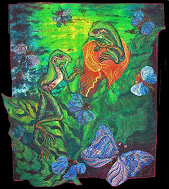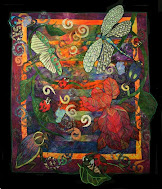Monday, July 12, 2010
Color Theory for Thread: Basic Shading for Embroidered Appliqué
When I embroidery images,every so often someone will say to me, "Do you really need all those threads?"Well of course!
Now, don't be silly. We know the answer to the age old question, "How many mushrooms do you put in a quiche?" The answer, of course, is" How many mushrooms do you have?"
But it's not exactly that reason. You don't pull in a million colors because you could. You do because it's how nature is. It's all about variance.
If you're going to shade something, you start with some color decisions. First we zone our design. Zones are areas that are fundamentally different colors.His tail and eye ring are one zone, his body and his ear others. His eye is separate because we'll do it in Sliver thread to make it shiny.
In each zone, you'll need a dark, medium and light value. If it's a larger piece you can have separate out your areas as having darks mediums and lights of their own. I've drawn lines to separate the areas, but they're not hard and fast. I'll just start adding lighter threads into the mix at those lines.
To weight the embroidery, I'll add a shader at the bottom of each area. A shader can be a darker complement to the color or dark blue, grey, brown, green or purple.
To lift the color and make it more exciting, we'll add a shocker right before the last color. It can be a bright complement to the basic color or orange, lime, hot pink, or bright purple.
Here's the range of colors I chose for this squirrel. He's basically orange, but all those colors go into making him shine and shimmer. Purple is my shader and the blues make a great shocker to keep the eye happy and entertained.
Wrapping it up:
Now, don't be silly. We know the answer to the age old question, "How many mushrooms do you put in a quiche?" The answer, of course, is" How many mushrooms do you have?"
But it's not exactly that reason. You don't pull in a million colors because you could. You do because it's how nature is. It's all about variance.
If you're going to shade something, you start with some color decisions. First we zone our design. Zones are areas that are fundamentally different colors.His tail and eye ring are one zone, his body and his ear others. His eye is separate because we'll do it in Sliver thread to make it shiny.
In each zone, you'll need a dark, medium and light value. If it's a larger piece you can have separate out your areas as having darks mediums and lights of their own. I've drawn lines to separate the areas, but they're not hard and fast. I'll just start adding lighter threads into the mix at those lines.
To weight the embroidery, I'll add a shader at the bottom of each area. A shader can be a darker complement to the color or dark blue, grey, brown, green or purple.
To lift the color and make it more exciting, we'll add a shocker right before the last color. It can be a bright complement to the basic color or orange, lime, hot pink, or bright purple.
Here's the range of colors I chose for this squirrel. He's basically orange, but all those colors go into making him shine and shimmer. Purple is my shader and the blues make a great shocker to keep the eye happy and entertained.
Wrapping it up:
- Pick a wide range of colors from dark to light for each zone. Go way lighter than you intend for highlights and way darker than you might to weight the piece.
- Pick a complement or very dark color to shade your piece.
- Pick a complement or very bright color to shock your shades.
- End with the color you want to see the most. You will.
Subscribe to:
Post Comments (Atom)
Ellen Anne Eddy's Flowers on Youtube.com
Labels
lunatic fringe
(22)
design
(18)
life as an artist
(18)
lifestyle
(18)
story telling
(11)
art quilting
(8)
fiber art
(8)
art quilters
(7)
books
(6)
color
(6)
free motion
(6)
gardening
(5)
Thread Magic Garden
(4)
embroidery
(4)
quilters
(4)
quilting
(4)
C and T Publishing
(3)
craft
(3)
flowers
(3)
Christmas
(2)
What problem?
(2)
archetypes
(2)
beads
(2)
bias
(2)
bobbin work
(2)
classes
(2)
filling the grid
(2)
sewing
(2)
threads
(2)
zigzag stitch
(2)
Wizard of Oz
(1)
choir
(1)
knitting
(1)
machine stitching
(1)
movies
(1)
seasons
(1)
youtube
(1)
Like us on Facebook

Quiltposium, Fall2011

Ellen's New Article, Dance of Design
Essential Embroidery Stitches: Free Hand and Machine Embroidery Designs and Techniques.
The Butterfly Effect

My Blog List
-
16 hours ago
-
2 days ago
-
1 week ago
-
4 weeks ago
-
3 months ago
-
2 years ago
-
4 years ago
-
5 years ago
-
5 years ago
-
6 years ago
-
6 years ago
-
8 years ago
-
8 years ago
-
8 years ago
-
9 years ago
-
9 years ago
-
9 years ago
-
10 years ago
-
10 years ago
-
10 years ago
-
11 years ago
-
11 years ago
-
11 years ago
-
12 years ago
-
12 years ago
-
12 years ago
-
12 years ago
-
13 years ago
-
13 years ago
-
13 years ago
-
13 years ago
-
13 years ago
-
13 years ago
-
13 years ago
-
13 years ago
-
-
-

Facebook Badge
Labels
archetypes
(2)
art quilters
(7)
art quilting
(8)
beads
(2)
bias
(2)
bobbin work
(2)
books
(6)
C and T Publishing
(3)
choir
(1)
Christmas
(2)
classes
(2)
color
(6)
craft
(3)
design
(18)
embroidery
(4)
fiber art
(8)
filling the grid
(2)
flowers
(3)
free motion
(6)
gardening
(5)
knitting
(1)
life as an artist
(18)
lifestyle
(18)
lunatic fringe
(22)
machine stitching
(1)
movies
(1)
quilters
(4)
quilting
(4)
seasons
(1)
sewing
(2)
story telling
(11)
Thread Magic Garden
(4)
threads
(2)
What problem?
(2)
Wizard of Oz
(1)
youtube
(1)
zigzag stitch
(2)



.jpg)










3 comments:
What a good lesson in color! Your squirrel is wonderful!
All of your lessons are wonderful and this one is particularly awesome. Your choice of colors is enlightening.
wow. I never would have thought to put purple on a squirrel, but it looks so right. great article, lots of good info. thanks for sharing.
Post a Comment